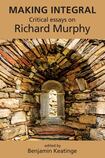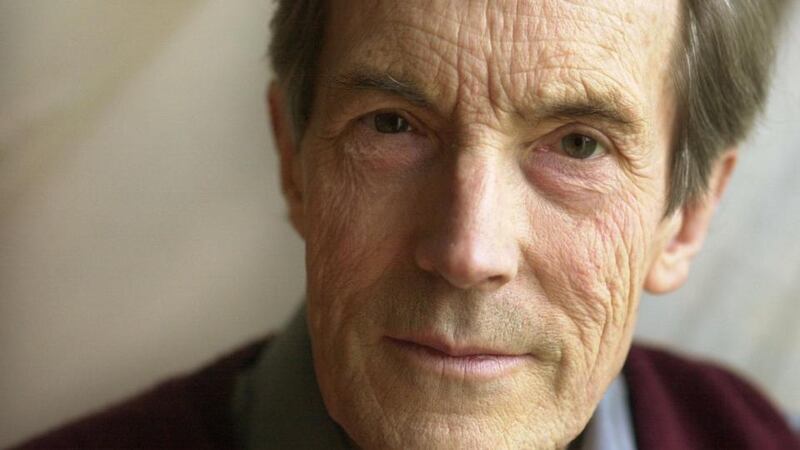
It is refreshing to meet a collection of critical essays that not only eschews jargon but also engages the reader in the connection between the life and the work. One might at first glance regret the absence of an explicit chronology of Richard Murphy, but the essayists so effectively draw the reader into the trajectory of his life that man and poet become an uneasy whole.
In this respect, the contributions by Maurice Harmon (doyen of Murphy studies), Philip Keel Geheber, Eve Cobain, James B Kelley and Barbara Brown are particularly valuable. Lucy Collins, on “Richard Murphy’s Island Lives”, Tom Walker on Murphy as a “radio poet”, Elena Cotta Ramusino on his autobiography The Kick, and Mark Wormald’s account of Murphy’s friendship with Ted Hughes, are exemplary studies. The meticulous bibliography, by editor Benjamin Keatinge, leaves everyone in his debt.
This collection, assembled with loving care by Keatinge, encourages the reader to explore simultaneously the life and the work in the spirit intended in the title: to integrate Murphy’s poetry not only with his contexts in Ireland, Ceylon/Sri Lanka, Africa and America, but also with his creative method, and in particular the copious notebooks in which he conceived the architecture of his poetry.

‘Spli-level life’
Although contributors are anxious to stress Murphy’s cosmopolitanism, and to insist that he is not exclusively an “Anglo-Irish poet”, it is nevertheless his ancestral background and his constant returns to Ireland – in particular Connemara – which affected him throughout his life. His grandmother’s house in Milford, Co Mayo, with its walled garden, was the starting point for Murphy’s lifelong search for a “hortus conclusus”.
Murphy referred to “my lifelong transgression” – meaning not trespass or violation, but an oscillation between states of being. “My split-level life” and “my split-heartedness” indicate not only his bisexuality but his inability to ever achieve the longed-for “home”. “Sailing to an island” is a transitus, not an arrival.
Murphy’s quest for calm security was fuelled by a mixture of nostalgia and anticipation. His restlessness caused numerous changes of habitat, each potentially offering – but failing – a return to that hortus conclusus. It also places him ideally to appreciate marginality. He came not only from a “hyphenated culture” but also from one bifurcated between the “big house” background and the peasant cottage. Again and again the essays quote Murphy’s mantra “Who owns the land?”.
Titles of volumes such as Sailing to an Island (1963), The Battle of Aughrim (1968) and High Island (1974) indicate Murphy’s simultaneous search for home and his homage to local history and myth, which is confirmed in poems such as The Cleggan Disaster(commemorating the drowning in 1927 of 25 fishermen in what became Murphy’s adopted village) or The Last Galway Hooker (celebrating a vessel Murphy purchased for his journeys to Inishbofin and High Island).
Connemara
There is also the contrast between an “open” mindset – epitomised by sky, sea and coast – and the “closed” world of the idyllic paradise of childhood. Murphy repeats expressions such as “the demesne walls of my mind”, but also affirms “the wish to belong in that distant impoverished bleak corner of Connemara”. In building his cottage in Cleggan he is divided between “the rootedness of an Irish cottage” and “the elegance of an Anglo-Irish home with a demesne”.
His habitual, almost neurotic, building of houses is mirrored by the architecture of his poetry, which is ably discussed throughout this volume: the sonnet form, at which he excelled, particularly exhibits his passion for structure, as epitomised in the ambiguously titled collection The Price of Stone (1985).
The failed experiments such as ownership, from 1969 until 1998, of High Island (it is currently on the market for €1.25 million), the building of a hexagonal house on Omey Island and his last seaboard home in Cleggan, where he tried to reconcile the two emotional poles of his life – the open and the closed – declare the impossibility of settlement. As Gerald Dawe puts it, “the sense of loss, of leaving a life behind, unfinished, pervades Murphy’s life as a poet”.
The poignant avowal in the lines “Alone I love/ To think of us together” and his statement that “love needs detachment and space as well as intimacy” underlines his “split-heartedness”. On a personal level, perhaps the most painful lines in his work are addressed to his newborn son by his short-term partner Anya Barrett: “Now that you’ve made this move/ To share our loneliness”. It’s a heartbreaking line for a poet who craved an identity withheld from him.
Murphy’s poems celebrate the fragile moments of conception, yet always look back to another time. We learn from him that memory cannot authenticate, or sustain, an identity: it can only call it into question.










